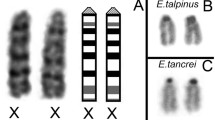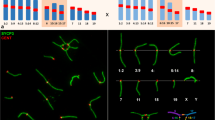Abstract
In female somatic nuclei, the W-chromosome forms a heterochromatic body, the so-called W-chromatin. This is absent in male nuclei. After a γ-ray treatment several mutations of W have been obtained. They influence the behavior of the W-chromatin in somatic nuclei. These mutations can be classified in three groups. The first group comprises five W-fusions. In females of these strains the W or a part of it is coupled to an autosome. During meiosis, these fusions pair with the Z and the homologous autosomes. The W-fusions disturb the normal formation of W-chromatin. Several smaller bodies are observed instead of a single W-chromocenter. The second type of mutation is a translocation between W and an autosome. Pairing in meiosis occurs only with the homologue autosome. It appears in 50% of males and 50% of females. In somatic nuclei it produces many very small particles of W-chromatin. The third type of mutation is represented by eight fragments of W. During meiosis, they form supernumerary fragment-chromosomes. In somatic nuclei, these are present as chromocenters similar to W-chromatin. W-fragments apppear approximately in one half of both sexes. By crossing, animals carrying up to four W-fragments could be produced. This heterochromatin additional to W-chromatin does not perceptibly influence either sex determination and fertility or quantitative characters such as duration of development, weight or diameter of eye facets.
Similar content being viewed by others
Literatur
Barigozzi, C.: The influence of the Y-chromosome on quantitative characters of Drosophila melanogaster. Heredity 5, 415–432 (1951)
Battaglia, E.: Cytogenetics of B-Chromosomes. Caryologia (Firenze) 17, 245–299 (1964)
Bauer, H.: Die kinetische Organisation der Lepidopteren-Chromosomen. Chromosoma (Berl.) 22, 101–125 (1967)
Bauer, H.: Rearrangements between germ-line limited and somatic chromosomes in Smittia parthenogenetica (Chironomidae, Diptera). Chromosoma (Berl.) 32, 1–10 (1970)
Bier, K., Kunz, W., Ribbert, D.: Struktur und Funktion der Oocytenchromosomen und Nukleolen sowie der Extra-DNS während der Oogenese panoistischer und merostischer Insekten. Chromosoma (Berl.) 23, 214–254 (1967)
Geyer-Duszynska, I.: Genetic factors in oogenesis and spermatogenesis in Cecidomyiidae. Chromosomes today 1, 174–178 (1966)
Keyl, H.-G., Hägele, K.: B-Chromosomen bei Chironomus. Chromosoma (Berl.) 35, 403–417 (1971)
Kühn, A., Henke, K.: Genetische und entwioklungsphysiologische Untersuchungen an der Mehlmotte Ephestia kuehniella. Z. Abh. Ges. Wiss. Göttingen, N. F. 15, 1–3 (1929)
Kunz, W., Trepte, H.-H., Bier, K.: On the function of the germline chromosomes in the oogenesis of Wachtliella persicariae (Cecidomyiidae). Chromosoma (Berl.) 30, 180–192 (1970)
Mather, K.: The genetical activity of heterochromatin. Proc. roy. Soc. B 132, 308–332 (1945)
Mittwoch, U.: Do genes determine sex? Nature (Lond.) 221, 446–448 (1969)
Mosbacher, G. C., Traut, W.: Geschlechtschromatin beim Schwammspinner Lymantria dispar und bei der Mehlmotte Ephestia kuehniella. Naturwissenschaften 55, 349–350 (1968)
Moss, J. P.: The adaptive significance of B-Chromosomes in Rye. Chromosomes today 1, 15–23 (1969)
Seiler, J.: Untersuchungen über die Entstehung der Parthenogenese bei Solenobia triquetrella F.R. (Lepidoptera, Psychidae). 1. Mitteilung: Die Zytologie der bisexuellen S. triquetrella, ihr Verhalten und ihr Sexualverhältnis. Chromosoma (Berl.) 10, 73–114 (1959)
Seiler, J.: Untersuchungen über die Entstehung der Parthenogenese bei Solenobia triquetrella F.R. (Lepidoptera, Psychidae). 4. Mitteilung: Umbau im Karyotyp der diploiden parthenogenetischen S. triquetrella von Alpe di Melano nebst Bemerkungen über Komplexchromosomen. Chromosoma (Berl.) 28, 298–308 (1969)
Suomalainen, E.: On the sex chromosome trivalent in some Lepidoptera females. Chromosoma (Berl.) 28, 298–308 (1969)
Tazima, Y.: The genetics of the silkworm. Bristol: Logos Press and Academic Press, 1964
Traut, W., Mosbacher, G. C.: Geechlechtschromatin bei Lepidopteren. Chromosoma (Berl.) 25, 343–356 (1968)
Traut, W., Rathjens, B.: Das W-Chromosom von Ephestia kuehniella (Lepidoptera) und die Ableitung des Geschlechtschromatins. Chromosoma (Berl.) 41, 437–446 (1973)
Umbach, W.: Entwicklung und Bau des Komplexauges der Mehlmotte Ephestia kuehniella Z. nebst einiger Bemerkungen über die Entstehung der optischen Ganglien. Z. Morph. Ökol. Tiere 28, 561–594 (1934)
Weber, F.: Korrelierte Formänderung von Nukleolus und nukleolusassoziierten Heterochromatin bei der Gattung Carabus (Coleoptera). Chromosoma (Berl.) 41, 437–446 (1971)
Author information
Authors and Affiliations
Rights and permissions
About this article
Cite this article
Rathjens, B. Zur Funktion des W-Chromatins bei Ephestia kuehniella (Lepidoptera) . Chromosoma 47, 21–44 (1974). https://doi.org/10.1007/BF00326269
Received:
Issue Date:
DOI: https://doi.org/10.1007/BF00326269




